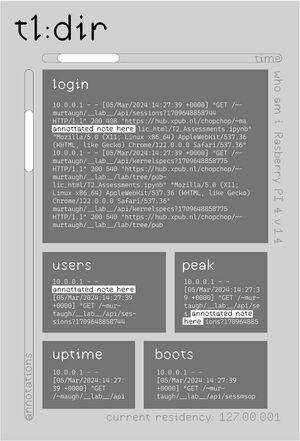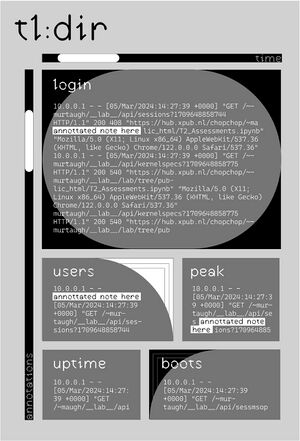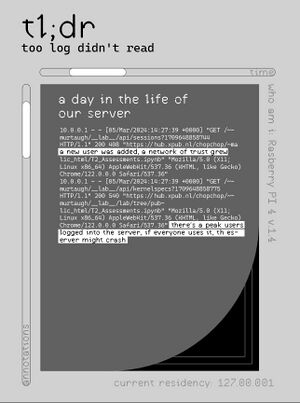Peripheral Centers and Feminist Servers/TL;DR: Difference between revisions
(Add tentative page structure and design images) |
(Add blurb draft) |
||
| Line 1: | Line 1: | ||
This page documents the tl;dr project part of [[Peripheral_Centers_and_Feminist_Servers]] | This page documents the tl;dr project part of [[Peripheral_Centers_and_Feminist_Servers]] | ||
''tl;dr'' researches ways to make sense of the hidden labour that goes on in a feminist server through log files and unlogged effort / activity. | |||
In a seamless world, awareness of techno-social infrastructure surfaces only when it's not working. But when you upload a photo, install an application, move a file, a technology serves, works, labours to execute what you've asked of it. | |||
Inaccessible files track this work as data. These files are inaccessible in two ways: they're hard to retrieve and hard to decipher. While these hidden files contain the not so hidden infrastructures of a server, they only manage to show a portion of it. After all, log files have a bias towards the technological ecology, prioritizing the labour a machine does. | |||
The actual infrastructure consists of much more: the people maintaining (rebooting, organizing, meeting) for the tech to work. A feminist data center acknowledges and fosters the infrastructure surrounding this technology; the physical labour, the decisions about shared spaces, the different knowledges that depend on each other for the network to exist. | |||
==Project description== | ==Project description== | ||
Revision as of 16:17, 13 March 2024
This page documents the tl;dr project part of Peripheral_Centers_and_Feminist_Servers
tl;dr researches ways to make sense of the hidden labour that goes on in a feminist server through log files and unlogged effort / activity. In a seamless world, awareness of techno-social infrastructure surfaces only when it's not working. But when you upload a photo, install an application, move a file, a technology serves, works, labours to execute what you've asked of it. Inaccessible files track this work as data. These files are inaccessible in two ways: they're hard to retrieve and hard to decipher. While these hidden files contain the not so hidden infrastructures of a server, they only manage to show a portion of it. After all, log files have a bias towards the technological ecology, prioritizing the labour a machine does. The actual infrastructure consists of much more: the people maintaining (rebooting, organizing, meeting) for the tech to work. A feminist data center acknowledges and fosters the infrastructure surrounding this technology; the physical labour, the decisions about shared spaces, the different knowledges that depend on each other for the network to exist.
Project description
[describe project matter of factly] [photos of project in varia during launch]
Motivation and evolution
[describe problem]
[initial idea]
[comments by Joseph and Manetta]
[updated idea]
Design process
[sketches go here]
[describe how sketches led to the following designs]
[describe 2024-03-13 meeting between Senka and Thijs that led to the following updated design]



